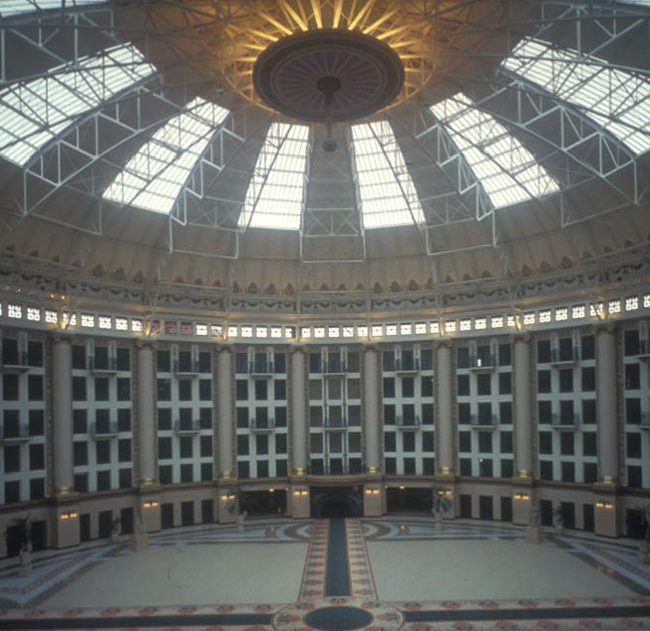Last updated: July 3, 2018
Article
Easements Protect West Baden Springs Hotel

National Park Service
Financial trouble associated with the Great Depression led the hotel to close in 1932. Between 1934 and 1964, the building served as a Jesuit seminary before the Northwood Institute, a private school of business management, acquired the building in 1966. In 1983, Northwood Institute closed its West Baden Springs, Indiana campus and ownership of the property transferred to a real estate developer.
At the time of its designation as a National Historic Landmark on February 27, 1987, the West Baden Springs Hotel had an uncertain future. Over the next few years, the building stood vacant and decaying while changes in ownership and a bankruptcy dimmed hopes that it would find a respectful steward.
In July 1996, Historic Landmarks Foundation of Indiana (HLFI) purchased the building with donated funds and began working assertively to find a new owner who would rehabilitate the 508 room hotel. Cook Group, Incorporated, a medical device manufacturing company, worked closely with HLFI to fund an extensive $35 million restoration that began in 1996 and continued until 2004. In 2006, following the Indiana State Legislature’s approval of a casino license for a facility near the West Baden Springs Hotel site, hotel use again became economically viable. A grand opening in June 2007 celebrated the completion of the hotel’s protracted renovation project. Today, the West Baden Springs Hotel and the adjacent historic French Lick Springs Hotel operate as part of a $342 million casino and resort complex. HLFI provides daily tours of the West Baden Springs hotel and grounds.
To guarantee the building’s continued preservation, the West Baden Springs Hotel has a preservation easement monitored by HLFI. Under the easement agreement’s binding terms, the hotel’s current and future owners will maintain the building’s character defining features in perpetuity and HLFI will perform annual inspections. Administrative and legal costs associated with this monitoring are considerable, so HLFI requires easement donors to contribute an amount commensurate with the size of the easement to ensure appropriate resources for monitoring.
Building owners benefit financially from easement donations to HLFI, as federal tax laws allow easement donors to make an income tax deduction for the difference in the fair market value of a property before and after the easement. In many cases, this difference can be significant, as an historic property subject to competing development pressures might lose market value when subject to binding legal restrictions on its use.
In July 1996, Historic Landmarks Foundation of Indiana (HLFI) purchased the building with donated funds and began working assertively to find a new owner who would rehabilitate the 508 room hotel. Cook Group, Incorporated, a medical device manufacturing company, worked closely with HLFI to fund an extensive $35 million restoration that began in 1996 and continued until 2004. In 2006, following the Indiana State Legislature’s approval of a casino license for a facility near the West Baden Springs Hotel site, hotel use again became economically viable. A grand opening in June 2007 celebrated the completion of the hotel’s protracted renovation project. Today, the West Baden Springs Hotel and the adjacent historic French Lick Springs Hotel operate as part of a $342 million casino and resort complex. HLFI provides daily tours of the West Baden Springs hotel and grounds.
To guarantee the building’s continued preservation, the West Baden Springs Hotel has a preservation easement monitored by HLFI. Under the easement agreement’s binding terms, the hotel’s current and future owners will maintain the building’s character defining features in perpetuity and HLFI will perform annual inspections. Administrative and legal costs associated with this monitoring are considerable, so HLFI requires easement donors to contribute an amount commensurate with the size of the easement to ensure appropriate resources for monitoring.
Building owners benefit financially from easement donations to HLFI, as federal tax laws allow easement donors to make an income tax deduction for the difference in the fair market value of a property before and after the easement. In many cases, this difference can be significant, as an historic property subject to competing development pressures might lose market value when subject to binding legal restrictions on its use.

Photo courtesy of Marsh Davis, HLFI.
HLFI annually monitors conditions at its approximately 400 easement properties across Indiana through active communication with current building owners and staff‐conducted conditions assessments. In rare cases where owners alter a property and ignore the terms of an easement, HLFI pursues court cases to maintain compliance.
Originally published in "Exceptional Places" Vol. 2, 2007, a newsletter of the Division of Cultural Resources, Midwest Region. Written by Tom Duda.
